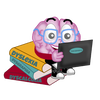Dyslexia and Autism are two neurodevelopmental conditions that have been extensively examined by researchers. Although separate, studies show that they often co-occur, with individuals having a diagnosis for both conditions.One of the most notable similarities between Dyslexia and Autism lies in their shared impact on verbal communication and both are linked to difficulties with sensory processing. Dyslexia is characterized by difficulty with reading, writing, or communicating. While individuals with Autism often have challenges with speech, communication, language, and interpreting nonverbal cues. Suggesting an overlap in the affected areas of the brain between these two conditions. Both conditions are frequently diagnosed in childhood, because children often experience social difficulties, struggle with academic performance, and face challenges in adapting to new situations. Dyslexia is known to affect reading and writing abilities, while Autism can have an impact by numerous academic skills.
Several studies have indicated a significant overlap between Dyslexia and Autism. For example, a study published in the Journal of Autism and Developmental Disorders found that approximately 30% of individuals with Autism also have Dyslexia. A study by Peterson and Pennington (2015) found that 29% of children with Dyslexia are also on Autism Spectrum Disorder (ASD) symptoms. The prevalence rates can vary however, they do show that there is a significant overlap between Dyslexia and Autism. While there are certainly similarities between Dyslexia and Autism, there are also some key differences. One of the most significant differences is the fact that Autism is typically characterized by difficulties with social communication and interaction, as having limited or very focused interests, as well as repetitive patterns of behavior, interests, or activities. In contrast, Dyslexia primarily affects abilities associated with words, although it can also impact other areas of life as well. Another difference between these two conditions is the way they are diagnosed. Dyslexia is typically diagnosed through an assessment of reading abilities by a school or private psychologist or neurologist, while Autism is diagnosed based on observed behaviors and social communication skills by a doctor. Additionally, there is often a greater emphasis on identifying Autism at an earlier age, as early intervention while school administrators and teachers tend to encourage parents to wait and see if the child outgrows the learning challenges. The reason for the comorbidity of these conditions is not yet fully understood, however it is believed that genetic and environmental factors may play a significant role. Researchers have identified genetic variations that may increase the likelihood for both conditions. In summary, while Dyslexia and Autism share some similar characteristics, they are two distinct conditions that require personalized support and intervention. Continued research can lead to a better understanding of their relationship, but for now, it is important to approach them as two completely different conditions that affect the brain of individuals in different ways. Reference: Lyytinen, H., Lyytinen, P., Laakso, M. L., & Poikkeus, M. (2009). Early identification and prevention of dyslexia: Results from a prospective follow-up in children at familial risk for dyslexia and other learning disabilities. Journal of Abnormal Child Psychology, 37(1), 49-64. doi: 10.1007/s10802-008-9259-3 Peterson, R. L., & Pennington, B. F. (2015). Developmental dyslexia. Annual Review of Clinical Psychology, 11, 283-307.
0 Comments
Your comment will be posted after it is approved.
Leave a Reply. |
LEXIA LEARNERS LOUNGE
AuthorJess Arce is a homeschool mom of four, a tutor for children & adults who struggle with Dyslexia & Dysgraphia and an all around entrepreneur. She is passionate about helping others understand dyslexia. |
